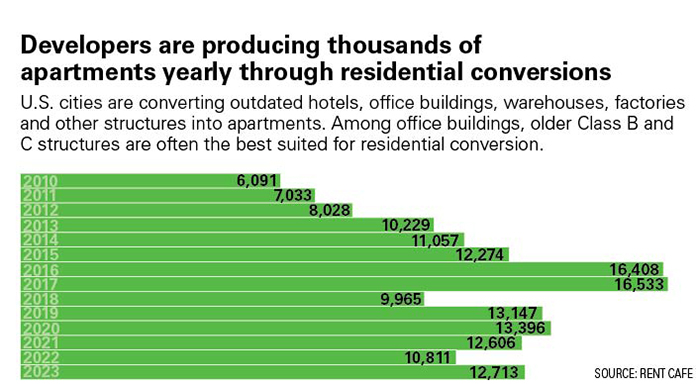Hybrid work is likely here to stay. This shift isn’t just changing lifestyles—it’s also affecting commercial spaces. Office vacancy rates post-COVID shot up almost overnight, and they remain near 20 percent nationwide, the highest rate since 1979 as tenants downsize in place or relocate.
This workspace surplus is putting pressure on existing development loans and leading to defaults or creative refinancing in a market already plagued by higher interest rates.
Office tenants with deeper pockets have gravitated to newer and larger buildings with more amenities, often referred to as Class A or “trophy” buildings. Older Class B and C buildings, which often have fewer amenities or less-desirable locations, have struggled to fill space.
High vacancy rates are forcing developers to get creative. With reduced demand for older buildings, along with housing shortages in many American cities, some downtown buildings are being converted to residential use.
These projects often include some percentage of affordable housing, underwritten by tax incentives. In October 2023, the Biden administration released a list of federal loan, grant, tax credit and technical assistance programs that can support commercial-to-residential conversions.
As an architect, I’m encouraged to see these renovations of older commercial buildings, which are more economical and sustainable than new construction. In my view, they are fundamentally changing the character of our cities for the better. Even though only about 20 to 30 percent of older buildings can be profitably converted, architects and developers are quickly learning how to grade these structures to identify good candidates.
From workplace to living space
In the decade leading up to the outbreak of COVID-19, developers converted more than 110,000 apartments from outdated hotels, office buildings, factories, warehouses and other buildings across the U.S. According to industry data, more than 58,000 apartments are currently being converted from office buildings.
Several characteristics of older Class B and C buildings make conversion particularly attractive. These buildings typically have smaller floor plates—total square footage of space per floor. Importantly, they also have shorter “core-to-shell” distances—the distance from the building core that contains stairs and elevators to the window wall.
Residential building codes generally require that natural light reach most rooms. Since living spaces, bedrooms and bathrooms are often separated by walls, a smaller core-to-shell distance allows more rooms to access natural light, making the conversion easier.
In contrast, typical new office buildings have larger floor plates and core-to-shell distances that can exceed 50 ft. This makes them more difficult to convert to residences.
But it’s not impossible. One creative solution involves moving the window wall inward by several feet to create outdoor decks. That’s an appealing amenity, but also an extra cost. In some conversions where the core-to-shell depth is greater than needed, developers have added interior vertical shafts or window wells to bring daylight to interior spaces.
Many older commercial buildings also offer higher ceilings, which are especially desirable in the residential market. Apartments and condos typically don’t need to conceal mechanical and electrical services with suspended acoustic tile ceilings, as offices do, so they can provide 12 ft. or more of clear ceiling height.
Some older buildings, including many made of brick or stone, have large windows, which also are desirable in residential use. Conversely, smaller windows or higher sill heights may be disincentives to conversion.
Many older buildings were constructed before air conditioning was widely available, so they have operable windows. This is yet another plus for residential conversion, since occupants typically desire natural ventilation in their dwelling unit.
Obstacles to conversion
Some characteristics of older buildings can make residential conversion difficult. For example, location always matters. Buildings that are far from other amenities, such as restaurants or grocery stores, may be less desirable.
Buildings with more unusual floor plates or geometric forms that work for office use may be difficult to carve up into residential units. Older structures that contain asbestos or lead paint can require expensive remediation.
Zoning laws may bar residential use or otherwise limit what can be done with a building. Cities can play an important role in encouraging residential conversions by revisiting zoning codes or offering tax incentives to developers.
One of the biggest costs of a residential conversion is the need to replace building systems such as plumbing and heating. Plumbing requirements in commercial office spaces, for example, are largely met with restroom facilities in the building core. Apartments or condos each require their own bathroom and kitchen, adding significant cost.
Return to walkable cities
As more downtown office buildings are converted to residential use, many of them are likely to house restaurants, day care facilities, grocery stores and other service businesses, typically on their ground floors. These amenities contribute to the financial success of a project and to the vibrant lifestyles of its residents.
All of these shifts prompt questions. Can architects and developers find ways to design buildings that serve multiple uses over several centuries, rather than a single targeted use that becomes obsolete in 100 years? Can mid- and high-rise buildings be envisioned as flexible structural grids, with lower-cost and easily changeable modular inserts? Such structures could accommodate ever-changing needs, some of which we may not yet know will be critical to the urban infrastructure.
Converting downtown offices to residential use could be just the starting point. And it’s a reminder that dynamic cities can reinvent themselves in response to challenges.
Excerpt Vivian Lam, theconversation.com















